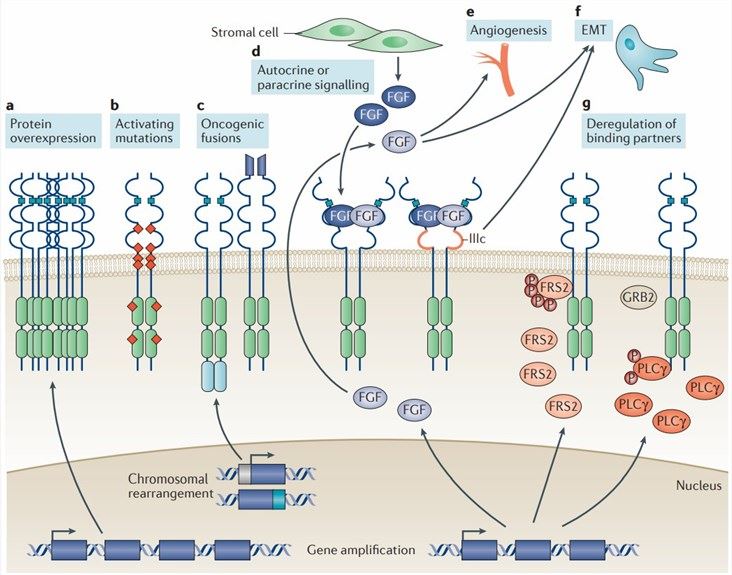What is FRS2 Protein
The fibroblast growth factor receptor substrate 2 (FRS2) protein is key to cell signaling, coordinating molecular events critical to cellular homeostasis.
What is FRS2 Protein?
FRS2 is an adaptor protein, meaning it acts as a bridge between cell surface receptors and intracellular signaling pathways. The structural landscape of FRS2 is defined by the phosphotyrosine-binding (PTB) domain, Src homology 2 (SH2) domain, and multiple tyrosine phosphorylation sites. These elements equip FRS2 to serve as a molecular nexus, facilitating interactions that are pivotal for cellular responses.

Figure 1. Mechanisms of oncogenic fibroblast growth factor receptor signalling. (Babina, I., et al. 2017)
The Function of FRS2 Protein
- Signal Transduction
FRS2 primarily acts as a crucial adaptor protein in the FGF receptor signaling pathway. When FGF binds to its receptor on the cell surface, FRS2 becomes phosphorylated at specific tyrosine residues. This phosphorylation event activates FRS2, allowing it to recruit downstream signaling molecules. The intricate network of interactions ultimately leads to the activation of various cellular responses, including cell proliferation, differentiation, and survival.
- Cellular Growth and Differentiation
One of the fundamental roles of FRS2 is its involvement in regulating cellular growth and differentiation. By relaying signals from the FGF receptor, FRS2 contributes to the intricate control of cell division and specialization, crucial processes in embryonic development and tissue maintenance.
- Neuronal Development
FRS2 has been implicated in the development of the nervous system. Studies have shown that FRS2 is involved in neuronal differentiation, axonal growth, and synapse formation. Its role in neurodevelopment highlights the diverse functions of this protein in various tissues and organs.
FRS2-Related Diseases
- Cancer
Dysregulation of FRS2 has been linked to various types of cancer. The overexpression or mutation of FRS2 can lead to aberrant activation of the FGF signaling pathway, promoting uncontrolled cell growth and contributing to the development of tumors. Understanding the role of FRS2 in cancer biology is essential for the development of targeted therapies.
- Cardiovascular Disorders
FRS2's involvement in the FGF signaling pathway extends to cardiovascular development and homeostasis. Disruptions in FRS2 function have been associated with cardiovascular disorders, emphasizing its significance in maintaining the health of the cardiovascular system.
- Neurological Disorders
Given its role in neuronal development, FRS2 has been implicated in neurological disorders. Altered FRS2 function may contribute to neurodegenerative diseases and developmental disorders of the nervous system. Investigating the specifics of FRS2 involvement in these disorders may unveil potential therapeutic targets.
FRS2 Related Signaling Pathways
- MAPK/ERK Pathway
FRS2 plays a pivotal role in orchestrating the Mitogen-Activated Protein Kinase/Extracellular Signal-Regulated Kinase (MAPK/ERK) pathway. The phosphorylation events initiated by FRS2 set off a cascade of molecular reactions, ultimately activating MAPK/ERK and regulating cell proliferation and survival.
- PI3K/Akt Pathway
In its regulatory prowess, FRS2 navigates the Phosphoinositide 3-Kinase/Protein Kinase B (PI3K/Akt) pathway. Activation of PI3K by FRS2 leads to the phosphorylation and activation of Akt, influencing diverse cellular responses, including anti-apoptotic signals and the promotion of cell survival.
Applications of FRS2 in Biomedical Research
- Targeted Therapies
The intricate understanding of FRS2's role in diseases, particularly cancer, opens avenues for precision medicine. Targeted therapies aimed at modulating FRS2 activity or its downstream effectors hold promise for regulating aberrant FGF signaling observed in cancer cells.
- Diagnostic Biomarkers
The identification of FRS2 as a potential diagnostic biomarker brings a new dimension to disease diagnosis. Monitoring FRS2 expression levels or phosphorylation status may serve as a valuable tool in deciphering disease signatures and advancing diagnostic methodologies.
- Drug Development
The FGF signaling pathway, under the influence of FRS2, emerges as a promising target for drug development. Small molecules or biologics designed to selectively modulate FRS2 or its downstream effectors hold potential for innovative therapeutic interventions.
- Neurological Therapies
FRS2's involvement in neuronal development positions it as a potential target for neurological therapies. Unlocking the specifics of FRS2 function in the nervous system may pave the way for strategies aimed at promoting neural regeneration and addressing neurodegenerative disorders.
FRS2 protein's involvement in signal transduction pathways, cellular growth, and differentiation underscores its significance in the intricate web of biological processes. The association of FRS2 with various diseases, including cancer and cardiovascular disorders, highlights its potential as a therapeutic target. As researchers continue to unravel the complexities of FRS2, its applications in biomedicine hold promise for developing targeted therapies, diagnostic tools, and novel treatment strategies.
Recommended Products for FRS2 Protein
| Cat.# | Species | Product name | Source (Host) | Tag |
|---|---|---|---|---|
| FRS2-28951TH | Human | Recombinant Human FRS2 | Wheat Germ | N/A |
| FRS2-23H | Human | Recombinant Human FRS2 protein, MYC/DDK-tagged | HEK293 | Myc/DDK |
| FRS2-22H | Human | Recombinant Human FRS2 protein, His-tagged | E.coli | His |
| FRS2-3641H | Human | Recombinant Human FRS2 protein, GST-tagged | E.coli | GST |
| FRS2-3091H | Human | Recombinant Human FRS2 Protein, Myc/DDK-tagged, C13 and N15-labeled | HEK293T | Myc/DDK |
| FRS2-3203H | Human | Recombinant Human FRS2 protein, His-tagged | E.coli | His |
| FRS2-6048M | Mouse | Recombinant Mouse FRS2 Protein | Mammalian Cell | His |
| Frs2-3087M | Mouse | Recombinant Mouse Frs2 Protein, Myc/DDK-tagged | HEK293T | Myc/DDK |
| Frs2-192R | Rat | Recombinant Rat Frs2 Protein, His-tagged | E.coli | His |
| FRS2-4430C | Chicken | Recombinant Chicken FRS2 | Mammalian Cell | His |
Reference
- Babina, I., Turner, N. Advances and challenges in targeting FGFR signalling in cancer. Nat Rev Cancer. 2017, 17: 318–332.

